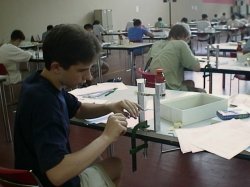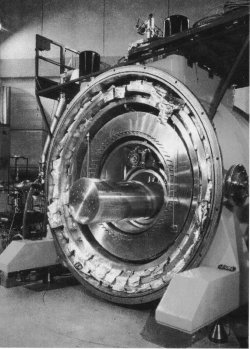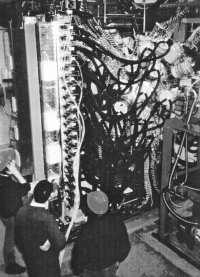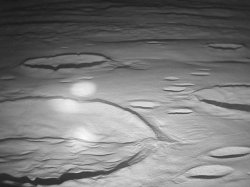
| The experimental exam: a characteristic moment of the Physics Olympiad |
IPHO '99 NEWS
- July, 22, 1999 -
Supplement to the n.3 of "La Fisica nella Scuola"
Managing Director: Luigi Brasini
THE LEADERS' VIEW
While the students were undertaking their practical exam, the leaders had a day off. "Even if we spent most of Monday night preparing the translations for the first exam - says Daniel Haryono from Indonesia - I was happy to take the tour to the marvellous Dolomiti mountains". Daniel is the organiser of the first Asian Physics Olympiad that will take place next year at the end of April in Indonesia. "One of the aims of organising an Asian Olympiad - he explains - is to generate new enthusiasm in the young physicists, but also to encourage close relationship among the Asian delegations". Further information can be found in the web page: http://www.ph.edu/apho2000/.
"Everything is going fine - says one of the Ukraine leaders - it is hot, but we have the same weather in Ukraine". The Finnish comment: "We have been visiting Padova, walking around in the town centre. We have seen lots of churches!". Others, instead, are still taking a rest for the nights spent awake. One of the Canadian leaders says: "I still did not have time to visit the town. This morning I was sleeping, but I hope to take a walk in the afternoon."

|
|
|
|
We also received some complaints. The Thai delegation reported a wallet stolen on Monday and have found difficulties moving around in town.
What about the correctors? Nobody has yet seen them. "We are working full time - says Silvia Pascoli - preparing for the correction of the theoretical exam. Unfortunately we cannot have any contact with the students, for obvious reasons, and so we cannot live in full the young and international atmosphere of the competition".
It seems that everybody is working hard! Anyway tonight we will all dance together with the open-air entertainment in "Prato della Valle".
By Francesca Rosati
Among all the interaction fields of nature (electromagnetic, weak and strong) the gravitational field has been known to man for the longest time. Its most distinctive and fundamental property (known as Principle of Equivalence) was recognized by Galileo and the Law of Gravitation was discovered by Newton in the XVII century. In the framework of the Newtonian theory, the gravitational force is described as a non local action with ėnfėnėte propagation speed. On the contrary, Einstein's theory of gravitation (General Relativity), as well as all the modern theories of gravitation, predicts the existence of the gravitational waves, i.e. ripples on space-time geometry which propagates through the empty space at the speed of light.
Gravitational waves strong enough to be detected on the Earth are emitted during catastrophic astrophysical phenomena such as a supernova explosion or a collision of two black holes.
Due to the complexity of the General Relativity, predictions about astrophysical sources of gravitational waves are quite difficult, but it is commonly believed that gravitational wave pulses impinge the Earth with a frequency of few events per month and amplitudes of the order of 10-21. This figure represents the perturbation on the relative distance (due to the change of the spacetime metric) of two free falling particles. The detection of such a small displacement challenge our abilities to push the detector parameters to (and often beyond) the limėts of the present technology.
 The gravitational wave detector AURIGA has been built to house a rnassive alunúnium cylinder, M=2.3t and length L=3m, with an high mechanical quality factor, Q=107, which resonates on fundamental longitudinal mode at the frequency v=920 Hz. A secondary small. resonator m = 0.3 Kg, locked to one of the end faces of the cy1inder, is tuned to the cylinder resonant mode and constitutes one of the plates of a capacitor charged to near break-down electric field. Such an electromechanical transducer efficiendy transforms the mechanical vibrational energy in an electrical. signal, which ís finally coupled to a superconducting quantum device, so called SQUID, serving as final amplifier.
The gravitational wave detector AURIGA has been built to house a rnassive alunúnium cylinder, M=2.3t and length L=3m, with an high mechanical quality factor, Q=107, which resonates on fundamental longitudinal mode at the frequency v=920 Hz. A secondary small. resonator m = 0.3 Kg, locked to one of the end faces of the cy1inder, is tuned to the cylinder resonant mode and constitutes one of the plates of a capacitor charged to near break-down electric field. Such an electromechanical transducer efficiendy transforms the mechanical vibrational energy in an electrical. signal, which ís finally coupled to a superconducting quantum device, so called SQUID, serving as final amplifier.
When a gravitational wave hits the cylinder, it causes extremely weak forces which, by changing its length, deposits a small amount of energy in the fundamental longitudinal mode.
To cope with external noise sources (from the environmental seismic, acoustic etc) which drives the oscillation of the cylinder we suspended it with a cascade of wire pendula, which serves as an effective, 250 db vibration insulation
Another noise source is inside the cylinder itself and it is due to the thermal motion of its atoms. To lower the thermal vibration noise the detector is cooled to ultralow temperatures T=100mK.
At the present, the AURIGA detector senses astrophysical bursts of gravitational waves in our Galaxy as those from supernova events and the final impact in the coalescence of collapsed binary systems. Rare milliseconds pulses, as those expected for the above mentioned signals, will be detected with an energy resolution, that is a small fraction of the average thermal energy and in prospects will approach a few quanta of vibrational energy in the fundamental resonant mode. At this sensitivity level the whole Virgo cluster of galaxies (about 2 500) will be in range.
When a sufficient number (more than 3) of detectors (bars or the new interferometric ones) are operating in coincidence, they will operate as a gravitational wave observatory, able to reconstruct direction and versus of propagation and polarization of the signals. A new tool will be available, which will probe processes in which the gravitational force gets uniquely stronger than nuclear and subnuclear interactions.
by INFN National Laboratory of Legnaro
 One of the most successful improvements in experimental nuclear physics in recent years has been the construction of big germanium arrays. This led to a large number of results with the discovery of new phenomena like magnetic rotation, exotic shapes, superdeformation etc. The exotic properties of loosely-bound quantum systems will be soon accessible to the investigation through the use of radioactive ion beams. But even before, one can approach the proton drip line through nuclear reactions using stable beams and powerful detector systems like GASP and EUROBALL. The investigation of the structure of nuclei close to the proton drip line can shed some light on basic problems like, for example, the existence of a new type of nuclear superfluidity, new collective modes and novel new shapes Moreover the study of unstable nuclei and its consequence on the nuclear stability at the drip line strongly impacts our understanding of the synthesis of elements and of the nature and evolution of the stars.
One of the most successful improvements in experimental nuclear physics in recent years has been the construction of big germanium arrays. This led to a large number of results with the discovery of new phenomena like magnetic rotation, exotic shapes, superdeformation etc. The exotic properties of loosely-bound quantum systems will be soon accessible to the investigation through the use of radioactive ion beams. But even before, one can approach the proton drip line through nuclear reactions using stable beams and powerful detector systems like GASP and EUROBALL. The investigation of the structure of nuclei close to the proton drip line can shed some light on basic problems like, for example, the existence of a new type of nuclear superfluidity, new collective modes and novel new shapes Moreover the study of unstable nuclei and its consequence on the nuclear stability at the drip line strongly impacts our understanding of the synthesis of elements and of the nature and evolution of the stars.
by INFN National Laboratory of Legnaro
Thirty years ago, at dawn of July 21St, at 4:56 Italian time, the man fulfilled his dream: landing on the Moon. What had been science fiction in the book by Jules Verne, From the Earth to the Moon' became reality with the Apollo 11 mission.
This anniversary will be celebrated with a show about the Moon that will be set up in the prestigious frame of the "Palazzo della Ragione", and it will also be a good opportunity to talk about our natural satellite, the only one among the forest of the artificial satellites that surround the Earth today.
 It will allow us to illustrate all the scientific circumstances that saw the Moon as a protagonist since that October 1609, when Galileo, here in Padua, first started to disclose the true nature of its surface. The large number of space missions, Soviet and American, have contributed to disclose many mysteries, but other fascinating discoveries are coming to light with the most recent space missions performed with the probes Clementine and Lunar Prospector.
It will allow us to illustrate all the scientific circumstances that saw the Moon as a protagonist since that October 1609, when Galileo, here in Padua, first started to disclose the true nature of its surface. The large number of space missions, Soviet and American, have contributed to disclose many mysteries, but other fascinating discoveries are coming to light with the most recent space missions performed with the probes Clementine and Lunar Prospector.
Let's have a look on the exhibition path: starting from Galileo, who first outlined the characteristics of lunar surface, we will show the original maps that the astronomers of the 15th century, after the great Pisan scientist, started to draw by using telescopes with more and more perfect opticses. The run of this evolution, either scientific and technological, will be illustrated through the 1 5th century Galilean telescope exposition, through refractor and reflector telescopes from1700 to 1800, volumes and lunar maps of the 1 5th ,1 6th and 1 7th century, up to the first photos, and the Moon photographic Atlases of our century, the very ones that allowed to choose the place of the first moon-landing.
Three examples of telescopes of modern construction, ~ each showing the characteristics of the opticses from the most ancient to the modern ones, will be shown, thanks to them it will be possible to observe at a distance a three dimensional model of a lunar crater in order to appreciate the improvement in the quality of the vowing with the perfectioning of the opticses.
The origin of the Moon is a fascinating matter: the hypothesis that the Moon originated from a gigantic impact between the Earth and a body of the dimensions of Mars has been confirmed by the probe of the NASA Lunar Prospector, whose model will be on view at the exhibition ~ Another sensational discovery is that of the water on the lunar poles; this has been made possible thanks to the images by the probe Clementine, whose prototype will be set up in the hall, close to all the original photos got by this mission.
A mechanical model and beautiful explanatory drawings will illustrate the movement of the Moon, the succession of the phases which give birth to those extraordinary spectacles such as the eclipses of the Sun and the Moon. The meaning of the synchronous movement will be explained, of the 'libration ' and of the so-called 'cinereous light' of the Moon.
The conquest and the landing on the Moon will have a special position inside the exhibition. The moon-landing area, within the "Mare Tranquillitatis",will be represented, and the whole documentation concerning that by now distant, event. The portraits of the astronauts who left their footprint for the first time on the lunar ground will be on view, a short biography of them, the large number of the preparatory Apollo missions to the moon-landing and the following ones, and the images either of the probes and of the close-up pictures of the Moon got by these.
The role of the Moon in the measuring of the time will be illustrated. From ancient times, in fact, the Moon has been the natural clock either for the prehistory man and for the ancient agricultural civilisations; it was due to the alternating of the lunar phases that the month, the week, the lunarsolar calendars took their origin.
Another fascinating theme will be touched in the show, the one of the influences of the Moon. Science has succeeded in showing a real association between the Moon and the numerous phenomena associated to its influence by the popular tradition, only as far as tides are concerned. In the field of Sea Biology scientists have by now recognised an effective association between the lunar phases and some biological phenomena, even if they still haven't succeed in giving a physical explanation. Such a complex theme will be illustrated with images, volumes and almanacs.
And finally another theme will be treated, that of the Moon of the future. The human settlement on the Moon foresees a series of projects that should come to light in the next decades: among these, the construction of a lunar outpost that, in a first time, should have been inhabited permanently by human beings. Neverthless, in recent years the new projects tend towards totally automized stations .
In the exhibition people will be illustrated the different stages necessary for the construction and activation of the projects :the launch of a satellite for telecommunications, the use of lunar vehicles for external activities, the installation of a set of aerials and of automized optic telescopes, to be located on the hidden side of the Moon, that will become in this way a privileged observatory toward the rest of the Solar System, with a possible lunar radiotelescope able to catch signals from the stars nearby, and to continue the search for other existing civilisations, perhaps likely to live in our Galaxy.
HAPPY BIRTHDAY!
PRADIT TUMMAVETVITEE (Thailand)
ELISABETH CHAMBERLAIN (G.E.I. Team)